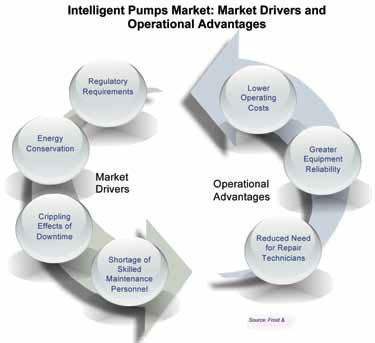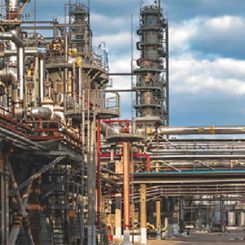Current analysis and future outlook
The advantages of adopting intelligent pumping systems has been well-documented, including the adaptability to process conditions, lower operating costs and contribution to decreased plant downtime. These advantages resonate in mature markets in which reduced maintenance staffs drive companies to improve process efficiency to maintain cost-competitiveness. Although demand is increasing, intelligent pumps have not yet enjoyed the wider adoption that their operational benefits would imply due to several restraining factors.
Market Overview
The intelligent pumping systems market has a number of key drivers that sustain demand. As a result of environmental regulations and incentives in North America and Europe, end users are increasingly searching for alternative ways to save energy, realizing that conventional pumps consume copious amounts of energy. Intelligent pumping systems can facilitate energy efficient processes. Another driver is the cost of unplanned plant downtime, primarily due to rotating equipment failure. These expenditures can have a significant impact on a company's profit margin, compromising its ability to survive in today's competitive markets.
The ever-present possibility of equipment failure also requires companies to retain a large in-house maintenance staff to monitor and repair this equipment in an efficient manner. With staffs dwindling due to an aging workforce, this poses a significant challenge to organizations. Intelligent pumping solutions can help mitigate maintenance labor challenges through facilitating equipment monitoring and reducing equipment wear. Despite these benefits, significant restraints exist for the implementation of these systems.
Sales of intelligent pumping systems are affected by the excess production capacity that currently exists in key end-user verticals. Without higher levels of industrial capacity use, expenditures on capital equipment are limited. This might only be a minor issue for the solution providers of intelligent pumping modules that are designed to control installed equipment. However, it can be a daunting challenge for solution providers of the more expensive, bundled intelligent pumping solutions. Another important limiting factor in the market is the shifting of industrial production toward countries with a low-cost labor force. The move toward overseas production reduces the demand for new pumping equipment in mature economies that benefit most from intelligent pumping solutions. In addition, intelligent pumping solutions have higher acquisition costs versus standard pumping equipment, which challenges solution providers to prove the cost-value ratio of their products to end users.

Value Chain—Challenges and Solutions
With these restraints in mind, what links of the value chain are optimally positioned to increase the technology's market penetration? Original equipment manufacturers (OEMs) of pumps can offer the broadest array of intelligent pumping solutions. Many have made strategic investments in adjacent technologies that can accommodate the necessary instrumentation. This has allowed them to bundle various products to provide turnkey solutions to end users. In addition to new systems, OEMs have also begun offering intelligent pumping modules that can be used to control existing pumps. Most of these modules are compatible only with the OEMs installed base of equipment, limiting their use. However, some firms have introduced vendor-agnostic modules that can control different OEMs' equipment. As manufacturers penetrate their captive equipment markets, the trend toward vendor-agnostic intelligent pumping modules is expected to strengthen, altering the competitive dynamics in this market.
One of the most significant growth challenges for the intelligent pump market for distributors is the need to develop the necessary instrumentation and electronics background to sell and support intelligent pumping systems. Although most large distributors can develop adequate expertise in-house, these investments in human capital can be prohibitively expensive for products that still need to demonstrate commercial potential. Another significant constraint includes the need for a strong local presence and the ability to configure new intelligent pumping systems. These factors are critical to distributors who want to facilitate a broader adoption of this technology. End users will only invest in intelligent pumping solutions if they are confident that the technology will be properly configured, seamlessly integrated and fully supported.
Aftermarket Benefits
Major OEMs can use intelligent pumping solutions to win asset management agreements with larger end users. Intelligent pumping systems allow end users to address shrinking headcounts. Therefore, asset management agreements become a natural way for manufacturers to act as force multipliers for their customers' maintenance staffs. One attractive feature of asset management agreements is that they enable an ongoing engagement with the end users. Intelligent pumps systems' reliance on instrumentation and data analysis tools offer improved outsourced service opportunities for OEMs.
Distributors benefit in a similar way to OEMs. Intelligent pumping solutions also give them a natural way to enter the asset management business with their end users while more tightly integrating their customers' businesses with their own. Asset management agreements make distributors more valuable channel partners to their OEMs by enabling stronger relationships with their end users. Finally, intelligent pumping aftermarket services allow distributors to expand their menu of pre-market services and product value enhancements.
Conclusions
There are several challenges impeding the widespread adoption of intelligent pumping systems in today's mature markets. To overcome these challenges and increase market penetration, solution providers must understand the needs of their customers and prove the product's value. Intelligent pumping solutions must be able to seamlessly integrate into a plant's existing infrastructure, reduce unplanned plant downtime and lower operating costs. Although this solution does require more specialized service and support, it also allows service providers to deepen their client relationships and have more sustained client engagements. If they make the effort to establish a strong knowledge base and develop a local presence to support their customers, distributors are well-positioned to benefit from investing in their intelligent pumping delivery capabilities.
Pumps & Systems, October 2010
Ram Ravi, an industry analyst with Frost & Sullivan, has expertise in growth consulting and research projects within the industrial process control and automation practice. He analyzes emerging trends, technologies and market dynamics for pumps, valves and compressor. Douglas Weltman, a research analyst with Frost & Sullivan, works on research and consulting projects in process control equipment, aftermarket services and welding technology. He examines enduser behaviors, disruptive technologies and industry best practices.

